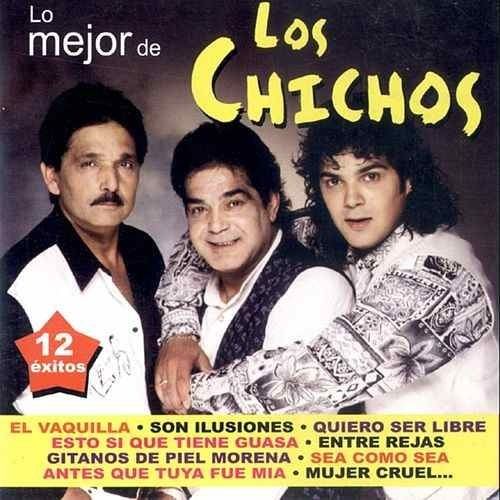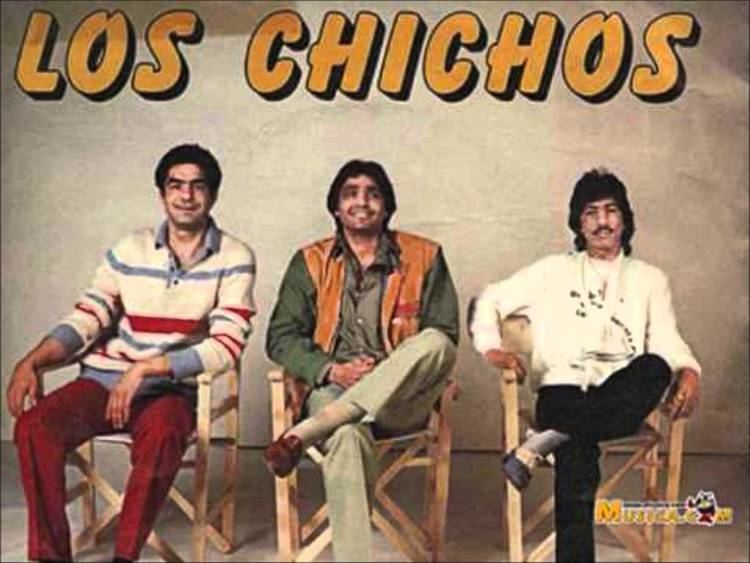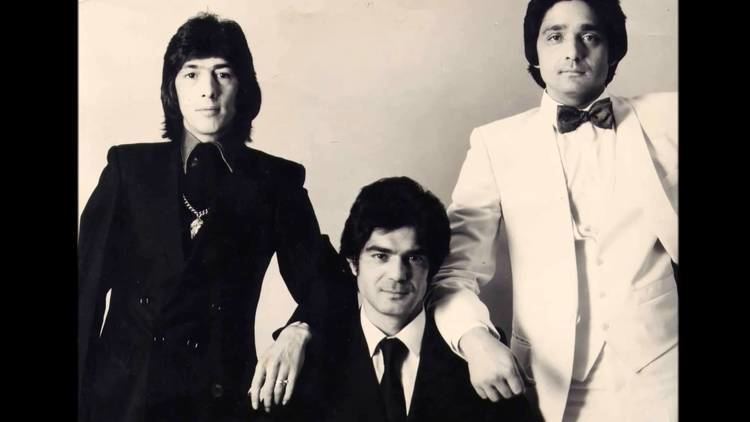Genres Rumba flamenca Labels Phonogram Genre Rumba flamenca | Years active 1973–1995, 1990–2008 Website www.los-chichos.com Record label Phonogram Inc. | |
Past members Juan Antonio Jiménez Muñoz † Albums Hasta Aquí Hemos Llegado, Homenaje a Jeros Members Emilio González Gabarre, Emilio González García, Julio González Gabarre, Juan Antonio Jiménez Muñoz Similar Los Chunguitos, La Hungara, Los Calis, Estopa, Camela | ||
Los chichos fantasmas en el bar demo por editar
Los Chichos is a Spanish Gypsies band which was formed in the mid 70's by the brothers Julio González, Emilio González and Juan Antonio Jiménez. It continued with its activity until the 1990s, with a peak point at the beginning of the 1980s. 20 million disks have been sold, making it one of the groups that have sold more music in the history of Spanish music. Their songs included different topics and themes from Spanish Gypsies' popular life, ranging from delinquency, violence and drugs, to love and life. Their music genre was the popular rumba flamenca in the vein of Los Chunguitos.
Contents
- Los chichos fantasmas en el bar demo por editar
- Start and ascension 1973 1980
- The first action
- Ascension
- Success 1980 1985
- The decline 1985 1990
- Reshaping 1990 2009
- Evolution
- Instrumentation
- Authors
- Los Grandes xitos de los Chichos
- Gitano
- 1974 1989
- 1991 2002
- Compilations
- Songs
- References

Start and ascension (1973-1980)

Emilio Gonzalez Gabarre learned to cope with the public in Salamanca, where a family member who introduced it in performances at parties of gentlemen. He accompanied his songs on the guitar. With them began to sing and make as much money his father doubted if his son committed crimes. He returned to Madrid and his brother Julio decided to accompany him. Furthermore, Eduardo Guervós liked and proposed to represent them. Since then beginning in Galicia, Spain ran without a driving license to get them contracts. Then came the need to nominate the group. A Emilio was called El Chicho and both brothers together people began to call Los Chichos. His fame grew as they sang every night for the hottest clubs.
The first action

His first professional gala made it in Vigo, in the New Electra room, then a very prestigious. Galicia is a good place for singers, because flamenco found it easy to find outside of Spain to the large number of immigrants who live there. Eduardo sealed the deal for action, the Board were forced to add another member. Eduardo he reiterated the importance of action and the publicity that would make him around town.

Both were excited but did not know whether to incoporpar as a drummer or someone who specializes in the bongos. "Look Jero, we give you 1000 hard if you come with us playing the bongos to Vigo", offered in July.

Juan Antonio Jiménez Muñoz (Jero) came from a neighborhood of Valladolid, but his father died just 7 years emigrated to Madrid. On the trip to Vigo, in a rickety train, Jero told his friends that he composed themes, if they wanted to hear. In the same train I took the guitar and sang "I wanna be free ... Free" Action in Vigo was a resounding success there began more and more performances. Jero settled in the group, and in fact became the soul of Chicane for many "chicheros" for his great compositions and excellent and distinctive voice, a real wonder.
Ascension
Appeared in 1973 in relation to a particular interpretation of the rumba flamenca Flemish, being pioneers in the music merger. Discovered by the father of Paco de Lucia, are presented to the Phillips and, with reservations, they begin to edit the first single s. Its success is such that immediately placed in the hands of the renowned master Torregrosa, which becomes the maker of a unique sound: rumba-rock recorded by the unique strong Dolby-B and a taste of the music appearing in the films of movie kinki and blaxploitation of the time (a powerful bass line, percussion and proud arrangement s orchestra, with the horn section sticking guns), as witnessed in turbulent doing stories that were about to tell: a repertoire that can be described as a song of the working class neighborhoods in the suburbs, these newly built which housed most humble walks of life and where the drug and crime began to rage. But there were also songs of extraordinary sensitivity, expressed directly by their irreplaceable voices. The author of all of them was Juan Antonio Jimenez, "Jeros", a gypsy become one of the best and most prolific figures has given the song Spanish. About the same time they are born Las Grecas, the gypsy-rock paradigm, and made them Jeros three themes for his first feature, highlighting especially "Orgullo" with its memorable electric guitar intro. The first three discs Chicchos represent a milestone in the Spanish pop-rock: spare not a single song and they are all potential singles. From the fourth, Emilio began writing songs, though not as inspired, and begin to include synth sounds, so their presence in all the clubs, billiards and bumper cars is already assured. The hard Hoy Igual Que Ayer has more about Chichos discounted as smoothed (though the lyrics of his hit "Mala ruinas tengas" is priceless, it gives up chills), and some of the songs seem overly melodic, much of the time (remember those films of scantily clad young ladies, as well: the tune of "I knew" or the album's title track could serve perfectly soundtrack). But with Amor y Ruleta, released in 1979 Chichos back on track: fast-paced rumba-rock, worth listening to loud in the cassette s of 1430 or the R-12. From there his TV appearances are constant (with a start scene of the three memorable), sales continue to rise through the roof and the concert s multiply until we have more days.
Success (1980-1985)
Encumbraron eighties as one of the musical phenomena of the decade. The album' shall dance with joy quickly became one of the most famous of his career. Philips then shielded them the contract, while the three were paced editing and composing a long-play per year.
In addition, cassette collections were sold in bulk. The LP Adelante presents new: synthesizers and a slightly arrangements techno very avant-garde that replace the old sounds orchestrated. While returning to the old a musical, considering most authentic in the next album, Yo, El Vaquilla, released in 1985, and written expressly for the film same name and reached an astonishing popularity.
Finally Chicane had their soundtrack, and his colleagues Los Chunguitos, who also triumphed, but between public more heterogeneous, integrated into the music market. Los Chichos now seemed to lose some strength.
The decline (1985-1990)
Over the next five years only take 4 studio albums. The internal strife (especially between Jero and July) and problems with drugs (a real bad dream that eventually relented only "cult") to speed the departure of Juan Antonio Jimenez. His final testament is a valuable double album live in the room Jácara Madrid with all its successes, leaving thousands of fans with the uncertainty of knowing what would happen to them. The Gonzalez brothers retake the group with the addition of Junior, the son of Emilio, who had replaced the Jero on some clothes. Definitely will be admitted after a concert at the Amusement Park Montjuïc in 1991. But the quality of the trio will suffer and their three albums in the 90s, with July as the new leader, will not reach the previous level. Meanwhile, Jero (aka "Jeros"), he produced two albums mediocre food for vending machines cassettes stations, although was still much admired and his figure was highly respected by all. Unfortunately not stand the situation and committed suicide at the end of 1995. It was a shock and recognized throughout the art world that had been a phenomenon. Years later, his son Chaboli (an outstanding musician) was brave enough to gather a lot of artists and admirers of his father get into a study to versioning your successes, but the result was not exceptional.
Reshaping (1990-2009)
Chicane have never ceased to be followers ("chicheros") or sell thousands of tapes, even in his worst moments. It is worthwhile to examine the fidelity of his acolytes. There is a story that perfectly describes the feeling that his music awakens: while they were singing songs from their latest album together on "The Matinee" of TVE in 1989 shows how the Andalusian journalist Irma Soriano nice jumps from his seat as lightning and is bundled to dance and sing absolutely delivered. In 2000, the reissue of a compilation in double CD made them again reach the top of the charts. With a more elegant, some changes in the themes of the songs and good production, became gold record with Ladrón de Amores, released in 2001. Something similar happened later with Cabibi, released in 2002. It is now imminent birth of a new work for 2009, "El Amor deja sentencia", while his whole discography is released compact. And doing this will not only increase sales (almost 20 million copies already) one of the most popular sets Spain of all time.
Evolution
The group's musical style is the Flemish in its variant of rumba and the fandango, merged with pop, with arrangements and production of Joseph Torregrossa, where the pioneers and creators of the style flamenco-pop witness who collected numerous groups such as Las Grecas Los Chunguitos Los Chorbos, Perlita de Huelva and, years later , sets like Tow. Moreover, its production ranges in specific cases, other styles. In fact they are heirs of Catalonian rumba, like all its kind, that imported from Cuba and upload speed, but supported by a base Flemish and / or folcklórica and seasoned with the sounds of the moment: pop and rock (remember Dolores Vargas "The Earthquake" for example) and so new, soul and funky. As mentioned above, this feature them on the Motown sound and the black musicians who recreated (Isaac Hayes, Marvin Gaye ...) for films starring Pam Grier and who claimed to own. For Chicane case with the Roma: a social group marginalized by society paya and Franco's dictatorship and wants to be enforced.
The musical evolution can be divided into: the first stage of 1973 until 1977 with "Ni más, ni menos 'to' Son ilusiones" and this album a transitional work and one of the most successful musical career in the trio. The second stage, from 1978 until 1983, with "Mala Ruina Tengas 'to' Déjame Solo", a period of extraordinary creativity and maturity, reaching their peaks in "Amor de Compra y Venta" in 1980. The third stage, from 1984 until 1985, covering his albums "Adelante" and "Yo, El Vaquilla", being the period of greatest artistic success and top the group. The fourth, 1986 until 1990, where it perceives a growing decline are less prolific than in the previous stages, reaching its nadir with the record "Ojos Negros "and the output of Jeros in 1990. And the last stage, the current, ranging from 1990 until today, and perhaps the hardest.
Instrumentation
The result of combining the rumba - Flemish and pop, with arrangements Torregrossa, produced a instrument varied and, while modern and traditional, where the basic training is battery guitars classical strings bass and wind s for most metals of the trajectory of the group. But other instruments will appear in successive stages between these include the password on piano, the synthesizer and percussion of as varied, involved in many songs trio, in particular the first two albums.
Regarding the voice there is also a remarkable variety in terms of combinations and given shares in the songs, with the addition of chorus s and female voices in many of them Roma. But there are two combinations that will be present throughout his career: the vocal trio and solo song sung by a member of the group. The teacher Torregrosa had in the book "We Chicane" costing him combine the voices of the three. Then over time, their complicity and experience allowed them to sing over each other without any crack. Generally, when one voice gripped most of the song used to be the composer of it. So, Jero used to sing their songs and the brothers Gonzalez made the choir. They versa. But in his first albums usually did all three in unison.
Authors
Jeros is the main, the most prolific and notable songwriter of the group. He composed all the material in the early and first stage, from 1973 until 1976 except on 1977 that Emilio wrote two songs. Juan Antonio Jimenez, Jeros, gypsy Valladolid, as we said earlier was one of a kind. Despite not having gone to school practically, his innate talent and sensibility marked him out quickly. He composed the first successes and single s who made fame and recognition to the trio, starting in 1974 with "Ni mas, ni menos", " Quiero ser libre "and" Te vas, me dejas "from his first album" Its importance as brain and central element of the group was vital throughout his career. The staging of the three, with him among the brothers and making as "speakers" (so says Valderrama in the book "We Chicane"), dressed in clothes first ye-yes, and then dressed up or sheathed in robes of spotless is not forgotten. The turns and twists of Emilio on stage were also house brand.
In 1977, the Gonzalez brothers begin writing material, contributing more and more songs, at first with the help of H. Humanes. It was logical that everyone wants their share by copyright, so in the end it is agreed that Jero four and they compose three each per disc. A song from the album "Bailarás con alegría" on "El Cuadro" was composed by the flamenco singer known as "El Luis" (Luis Salazar Barrul). The pace of the group composition was affected in the last stage of Jeros as a component: only two discs taken out in 1987 and 1988 and of lower quality than the previous ones.
From 1990, with Junior in the group, most of the material consists of the brothers Gonzalez. Junior brings some issues of his own creation, especially for the album "Gitano", but most are songs that were loaned to other and now are taking over. July continues to sing on those who betray and Emilio on women of the night. But the best song of his first without Jeros is "Nieve" written by the then popular Queco. The decade passes and suburban rumba does not seem to enjoy very good health. However, Chicane are more than a group, are a brand. And with the new century, his name shines again.
Los Grandes Éxitos de los Chichos
Gitano
(1974-1989)
(1991-2002)
Compilations
Songs
Sea como seaSon ilusiones · 1977
Ni más - ni menosNi más ni menos · 1974
Quiero ser libreNi más ni menos · 1974
